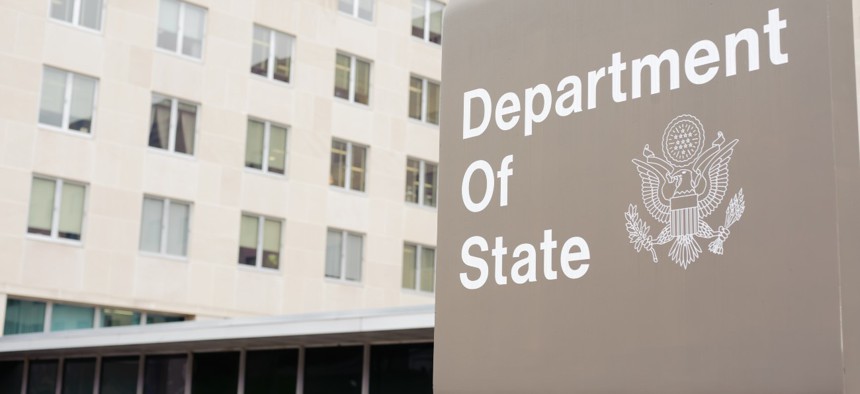
By Sorbis / Shutterstock.com
State Department Officials Vow Cultural Shift Toward Inclusion
Officials tasked with improving diversity told a House panel that they hope recent efforts to deploy unconscious bias training and conduct surveys of those leaving the department will help improve efforts to retain employees of color, women and members of the LGBTQ community.
Officials tasked with improving diversity and inclusion at the State Department told a House panel on Tuesday that they are hard at work examining how to boost the recruitment and retention of underrepresented groups in the department’s workforce, although progress is slow moving.
The fact that the State Department’s workforce, both civil service and foreign service, does not adequately reflect the demographic makeup of the United States is a longstanding issue. According to a Government Accountability Office report from earlier this year, although the total proportion of racial and ethnic minorities in full time jobs at the department has increased from 28% in fiscal 2002 to 32% in fiscal 2018, that increase has failed to take hold among the ranks of management and minorities now make up a disproportionately large contingent of those leaving the department.
“On retention, 25% of all people leaving [the State Department] in 2018 were racial minorities, compared to only 13% in 2003,” said Rep. David Cicilline, D-R.I.
Rep. Joaquin Castro, D-Texas, chairman of the House Foreign Affairs Subcommittee on Oversight and Investigations, said that the key to the department’s efforts is ensuring that promotions are distributed fairly, particularly since the department has seen gains in diversity at the frontline employee level, thanks in part to the success of the recently expanded Rangel and Pickering Fellowships.
“The Rangel and Pickering Fellowships are meant to bridge the existing gap in representation, not to be used as the sole means by which people of color are recruited,” Castro said. “The biggest challenge is not in recruiting racial and ethnic minorities, but in retaining and promoting them. During the promotion process, women and people of color don’t have equal access or chances of advancement.”
Carol Perez, director general of the U.S. Foreign Service and director of global talent at the State Department, said her office’s focus on diversity is a somewhat recent one—when she assumed her current role 18 months ago, only one staffer in her office was working specifically on the issue—but that she is working several initiatives across recruitment, retention and professional development to make progress. The department has expanded access to the fellowship programs by 50%, and it is working to improve mentoring programs as well as institute unconscious bias training across the professional development process.
“Effective strategic recruitment must be accompanied by internal cultural shifts that enable retention and ultimately career advancement, and that’s why I made fostering a culture of inclusion a priority from day one,” Perez said. “We have instituted new flexibilities and enhanced existing ones, like an extended [leave without pay] pilot, additional lactation rooms, flexible lunch schedules and a push to make more positions telework eligible . . . It also requires looking systematically at why some people do leave the department, and we have new centralized exit surveys to help identify potential patterns so that we can better address systemic issues as part of our retention efforts.”
Castro asked Perez how she is approaching confronting an issue so longstanding that it had been flagged by GAO as far back as 1989.
“What we have to do is get at the culture of the institution, and I have to be perfectly frank, when I talk to my predecessors about it, this is the hard part, because it’s not something that just became a problem two to five years ago, if you go back to 1989 it was a problem,” Perez said. “One difference for us now is that we are going through this diversity and inclusion strategic plan process, and we’ve made it very much a bottom-up process, engaging with communities and employee affinity groups to get buy-in. I don’t think I can change it alone, but if you all help me, the Congress, the community, I think we can get there.”
Cicilline noted that the department’s 2016-2020 diversity and inclusion plan calls for mandatory unconscious bias training for all employees, but asked why the department has yet to mandate such a program.
“The department [previously] listed mandating unconscious bias training for all employees as a top priority, but this is still not required of all employees, and you mentioned that it’s being ‘encouraged,’” Cicilline said. “It seems odd that this is a top priority but it doesn’t appear as if you’ve mandated it.”
“I’ve taken unconscious bias training twice, once in person in 2019 and then I took it again online, and afterwards I went up to the course facilitators and said, ‘This is great, everyone has to take this course,’” Perez said. “But they said, ‘Oh no, absolutely not.’ If you make something mandatory, they believed that it would be devalued. Now, that’s what they thought and I’m not an expert, so I started thinking: how can we integrate it into the fabric of everything we do, without making it mandatory.”
Perez also asked Congress for help in developing legislation that could enable the department to offer a broad paid internship program.
“The Foreign Service Act is very limiting, which is why we have the fellowship programs,” she said. “As we’ve found running the foreign service internship program, while we have a 30% conversion rate [to full time employment] for the fellowships, that compares to 7% for those who come in as normal interns. What I’d really like is a legislative fix to allow us to be able to offer paid internships to those who might otherwise not be able to do this, because for economically disadvantaged folks, they often have to choose between a job at McDonald’s and us, and I want them to be able to come to us.”







